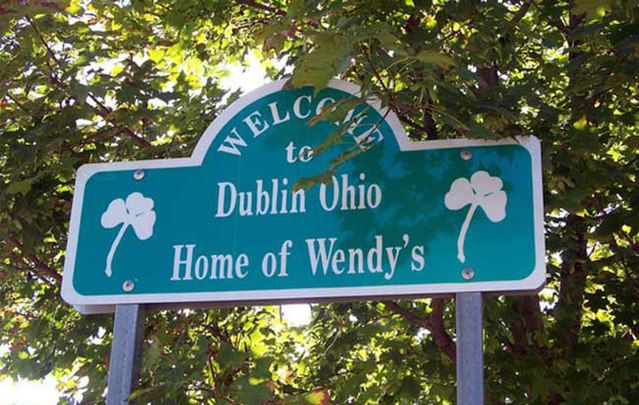There’s only one Dublin – Baile Átha Cliath, Fair City, the Big Smoke. Well, in Ireland, at least.
In the US there are not one, not two, but nine Dublins, and that number rises to eleven if you consider townships.
Dublin, Ohio
Dublin, Ohio is perhaps the best-known Dublin in the USA. The small city just outside of Columbus, Ohio got its name in 1810 when Benjamin and Peter Sells, two brothers from a German immigrant family, purchased a 400 acre parcel of land on the banks of the Scioto River and gifted it to their younger brother, John.
As fate would have it, Sells worked with an Irish land surveyor named John Shields, who was allowed to name the village. According to local lore, he rather poetically said, “If I have the honor conferred upon me to name your village, with the brightness of the morn, and the beaming of the sun on the hills and dales surrounding this beautiful valley, it would give me great pleasure to name your new town after my birthplace, Dublin, Ireland."
Dublin has seen remarkable growth, particularly following the construction of the I-270 highway, which caused the population to skyrocket. Dublin officially became a city in 1987. It hosts a big Irish fest every year and boasts many local landmarks that pay homage to its Irish namesake – an Abbey Theater, the Brazenhead Pub, and street names like Inishfree Lane and Phoenix Park Drive.
Dublin, California
Ohio’s Dublin isn’t the only one expanding in leaps and bounds – let's take a look at Dublin, California. Its Irish roots date back to 1850, when two Irishmen, Jeremiah Fallon and Michael Murray, purchased 1,000 acres of land in the Amador-Livermore Valley from Jose Maria Amador.
Many remnants of Dublin’s early days remain, including the Murray Schoolhouse, built in 1856 as the first schoolhouse in the valley. Donlan Way is a major thoroughfare, and the next town over is Dougherty, which split from Dublin decades ago.
Dublin, Georgia
Dublin, Georgia had the honor of being referenced by James Joyce in "Finnegans Wake": “Nor had topsawyer's rocks by the stream Oconee exaggerated themselves to Laurens County's gorgios while they went doublin their mumper all the time.” (The Oconee is Dublin’s nearest river).
The city was founded in 1812 and it’s believed that one of the founders, a man by the last name of Sawyer, decided to name Dublin after the capital city of his homeland. Today, the city celebrates its Irish roots with a month full of St. Patrick’s Day revelry and entertainment.
Even more Dublin
Dublin, Kentucky, an unincorporated community in the Bluegrass State’s Graves County, was named after Dublin, Ireland.
So too was Dublin, Virginia, a town in Pulaski County.
When the area became officially incorporated in 1771, Dublin, New Hampshire was named after the Irish birthplace of Henry Strongman, who had settled there in the 1760s.
Dublin, a borough of Bucks County, Pennsylvania, was also named after Dublin, Ireland, but things are not so straightforward in the cases of the towns of Dublin, Texas, and Dublin, Michigan.
According to the Texas State Historical association, Dublin, Texas, founded in 1854 in the Lonestar State’s central Erath County, was “named in 1860, probably for the warning cry at Indian raids, 'Double In,' for the capital of Ireland, or for the double-log cabins used by early settlers.”
As for Dublin, Michigan, according to local understanding the town’s name has little if anything to do with Ireland.
Rather, according to a 2007 article in the Record Eagle newspaper, “the name comes from the Pere Marquette Railroad that used to run through town. Trains from the north had to slow to cross a trestle 100 feet above the Manistee River and could not get up enough steam to climb the long, gradual grade from Wellston to Dublin. Engineers would leave half of their cars in Wellston and take the trains up the hill in two trips.”
In other words, they would double back, and from that “doubling,” the name “Dublin” evolved.
*Originally published in 2015. Updated in 2023.




Comments